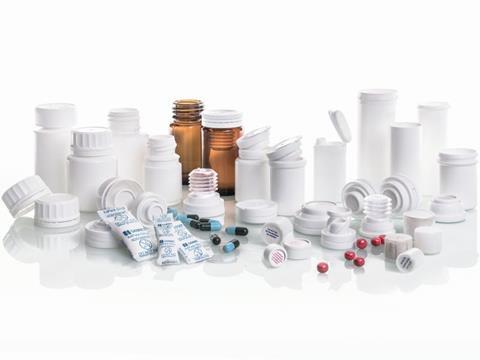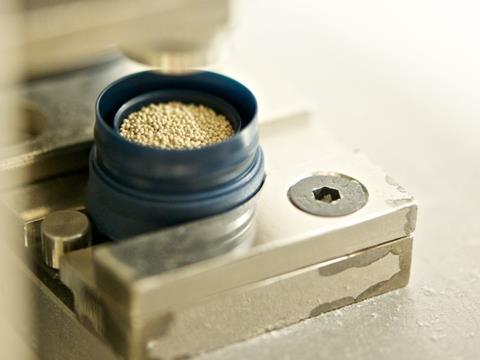
Before market introduction, a new pharmaceutical product must undergo a number of approval processes. These not only concern the new drug, but also its packaging.
Especially with moisture-sensitive drugs, a number of aspects must be considered to accomplish a safe, timely and cost-efficient market launch. Is the packaging tight enough, and is the drug protected against moisture ingress? Is the required shelf life ensured? Ursula Hahn, Head of Product Management at Sanner, describes how to achieve the ideal atmosphere inside each package.
Many common drugs are moisture-sensitive, for example tablets or test strips. The effects of moisture are many and varied, and can pose risks not only for the drug itself but also for patients. Most importantly, moisture can reduce the efficacy of pharmaceuticals, thus leading to a wrong medication. Blood or urine test strips may show misleading results. Moisture ingress can also lead to changes in the substrate material such as color loss or show smeared surfaces. Moreover, moisture ingress into the packaging can lead to an unpleasant odor.

The principles of adsorption
Consequently, protecting these products from moisture ingress is one of the key factors a primary packaging must achieve. How can this be done? The answer is adsorption, a physical procedure where specific molecules bind to the surface of an appropriate material and accumulate there. Depending on both application area and packaging requirements, different desiccants such as silica gel or molecular sieve can be used to protect the contents from moisture vapor contained in the air. These desiccants are hygroscopic. They attract moisture, thus keeping it away from the packaged contents.
Desiccants are especially designed to accumulate water molecules. Since adsorption is based solely on physical forces, desiccants must possess the relevant physical properties to set these forces in motion. This requires as many cavities as possible in the interior and exterior surfaces of the desiccants, resulting in a large surface area where moisture can accumulate. Both silica gel and molecular sieves retain moisture according to this principle. There are many different ways of equipping packaging solutions with desiccants. For instance, a desiccant closure serves as cap for tablet tubes. Alternatively, a desiccant chamber within the packaging provides in situ moisture protection, for instance in the bottom part. Desiccants can further be filled into capsules, canisters and sachets, which are used in bottles or containers – so-called drop-in desiccant solutions.
Silica gel or molecular sieves?
The most common type of desiccant is silica gel. It is glass-like in appearance but contains many small inter-connected channels opening as pores at the surface. The structure is similar to a sponge with a large inner surface area, adsorbing water molecules on the surfaces of the channels and pores. These pores are capable of adsorbing up to 36% of their own weight of moisture without changing their structure. Silica gel does not develop any vapors, is completely odorless. The adsorption capacity depends on the relative ambient humidity: the higher the relative humidity, the higher the adsorption capacity.
Molecular sieves, on the other hand, are synthetically produced zeolites with a regular pore diameter and a crystalline structure. These pores connect to a series of regular-shaped cavities where water molecules are attracted to the surface. Molecular sieves are mainly used when a very low humidity is required. Molecular sieves have a very low tare volume and an optimum adsorption capacity. They adsorb between 20 and 22% of vapor by weight, independently of the relative humidity. While silica gel reduces the humidity to a certain degree, molecular sieves can achieve a climate of close to 0% relative humidity in closed spaces.

Finding the ideal desiccant packaging solution
So what must be taken into account when selecting the appropriate desiccant packaging? If a product or packaging item requires a very low level of moisture, it is best to use molecular sieves. If the drugs in question are less moisture-sensitive, a silica gel desiccant will do. Together with many other information, such as product characteristics or filling conditions, the suitable packaging and the optimum amount of desiccant can be determined for a cost-effective and safe usage. At large, a checklist of five aspects helps to know what is needed:
• defining the ideal atmosphere inside the package by taking into account all moisture ingress factors that influence both active ingredients and substrate material;
• ensuring reliable risk mitigation by testing real packaging data instead of making projections with general data;
• ensuring a smooth integration of the chosen packaging solution into existing processes;
• achieving cost-effectiveness through tailor-made desiccant solutions;
• making use of a partner with long-time experience, leading to successful projects.
Creating the right atmosphere
Pharmaceutical products consist of both active ingredients and substrate material. It is often claimed that changes, for instance in color, smell or weight, lead to a loss of efficiency, or even that no change automatically means there is no loss of efficiency. However, this is not necessarily true for all drugs. For this reason, relying on such theories is not sufficient to ensure that drugs are protected against moisture ingress at all times. In fact, every single moisture ingress factor must be taken into account to maintain the ideal atmosphere and a defined climate corridor within a package. In general it can be said that moisture ingress varies decisively between different parameters:
• filling conditions: 15%
• usage: 15%
• initial product moisture: 5%
• permeation through the packaging: 65%
Only by taking all the above factors and – most importantly – the real package into account, can the ideal packaging solution for a specific product be found.
Real data does the trick
Material data sheets or data bases deliver data that result from very specific, ideal conditions. However, a real packaging will always differ from these results. This is also true when comparing the permeation of a plastic sheet with a real packaging. The reason is simple: an individually designed primary packaging is sure to have a different wall thickness at different positions. If the chosen solution consists of a combination of bottle and closure, the interaction of these two distinct elements is equally important.
A simple extrapolation of general material data regarding water vapor transmission will not do the trick. For this reason, using real packaging data for all analyses and testing the real packaging solution is paramount to achieve realistic and reliable data. As illustrated above, 65% of moisture ingress comes from permeation. Hence only real data and realistic analyses will avoid unnecessary trials and ensure shorter time-to-market for products and packaging solutions. A holistic approach to drug packaging is the safest way to achieve a safe and economic market entry, and includes all relevant factors: from material type and wall thickness, manufacturing-related impacts, handling during the filling process, and different climate conditions through to consumer behavior.
As much as needed, as little as possible
Based on the previous analyses and according to the motto “as much desiccant as needed, as little as possible”, the right and most cost-effective desiccant packaging solution can be found. How does the tightness correlate with the desiccant? Which desiccant is best suited for the specific requirements of a particular package? By taking into account the right parameters, costs can be reduced significantly. It requires the knowledge about the ideal interaction of product, desiccant, packaging and tightness. This approach will never lead to a standardized solution. Instead, a tailor-made desiccant packaging solution is required for each individual product.
However, it is also possible to optimize existing packaging solutions regarding their cost-effectiveness and suitability based on the same parameters. For instance, a packaging with an injected desiccant compound solution contains a larger amount of desiccant due to general design and process-related reasons. In a first step, both cap and container can be made even tighter, thus maintaining the design format and saving some desiccant. Step two consists in finding the exact amount and type of desiccant required for the specific content. Experience shows that the amount of desiccant that is really needed to achieve the required shelf life in some projects can result in 30% less desiccant – for every single package.
The right partner for the right climate
To find out what kind of packaging a new drug requires, it is important for pharmaceutical manufacturers to work with a partner, who knows all the technical and regulatory aspects of the process, who has established a good project management to quickly and efficiently carry out the packaging development, and who is able to produce large numbers while maintaining consistently high quality. Whether the result is a drop-in, an integrated or a completely individual desiccant packaging solution, it needs to be integrated smoothly into existing processes of the pharmaceutical manufacturer.
Hundreds of successful projects, developed over many years, are a good indicator for expertise and reliability. A primary packaging partner, who knows the industry and, most importantly, has designed a multitude of different desiccant solutions, is sure to be the best option. Tried and tested processes, reliable measuring results and successful stability tests, backed by processes that are in line with GMP requirements and international regulations are the best prerequisite for a safe, timely and cost-efficient market launch of new pharmaceutical products.
More info:










